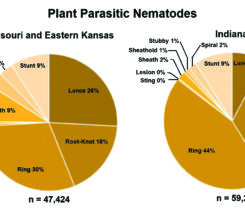Experts study how to stop nematodes in their tracks

A look at the combination of Divanem and Excalibur on June 4 after two applications. (photo by: Bruce Martin, Ph.D.)
What do you get when you mix a nematicide and a soil surfactant?
That’s exactly what Bruce Martin, Ph.D., CEO of Turf Research and Diagnostics and retired professor of plant pathology from Clemson University, sought to discover by setting up a study on a golf course that had a history of sting, root-knot and lance nematode infestations.
The study looked at bermudagrass plots with a mixture of nematicide Divanem and wetting agent Excalibur, Divanem by itself and Excalibur by itself. The study included four applications of each at recommended label rates on a monthly basis.
“The use of a surfactant in a nematode management program is not new,” Martin says. “(We knew) it helps if we fertilize properly, if we get better water distribution, if we don’t allow drought stress, etc. So, we were using the soil surfactant as another component in a nematode control program.”
The idea to combine the two came about because, Martin says, the nematicide by itself often binds to soil organic matter pretty tightly, and it’s difficult to get it down through the soil profile, where the roots are extending and where the nematodes may be concentrated and feeding on the roots.
“If we can’t get the pesticide to the pest, we’re going to get poor control,” Martin says. “We try to get around that by using a lot of water in post-application irrigation so that we can move it down with water, and that’s somewhat effective. That’s also where the addition of a soil surfactant would presumably help in moving the nematicide down deeper in the soil profile so that we get better contact of the nematicide with the nematode.”
All told, Martin says the combination of Excalibur and Divanem provided the best treatment.
“The interesting thing was that the Excalibur by itself was actually better from the standpoint of turf quality improvement than the nematicide by itself. So that was telling me this surfactant is a very powerful tool for managing the stress,” Martin says. “It’s allowing the water to be used more efficiently in a more uniform distribution, deeper in the soil profile.”
Sam Green, president at Aqua-Aid Solutions, cautions that the wetting agent is not a nematicide nor is it labeled as such.
“The wetting agent itself is not affecting the nematode, but it is exponentially helping the nematicide Divanem work better in the soil to combat the pest,” Green says.
However, Martin says that as summer temperatures increase and many parts of the U.S. contend with higher nematode populations, this technique could prove to be useful.
“A soil surfactant on greens is fundamental, whether it’s cool-season grasses or warm-season grasses,” Martin says. “It just gives superintendents a tool crucial for improving the outcome of a nematode control program.”











